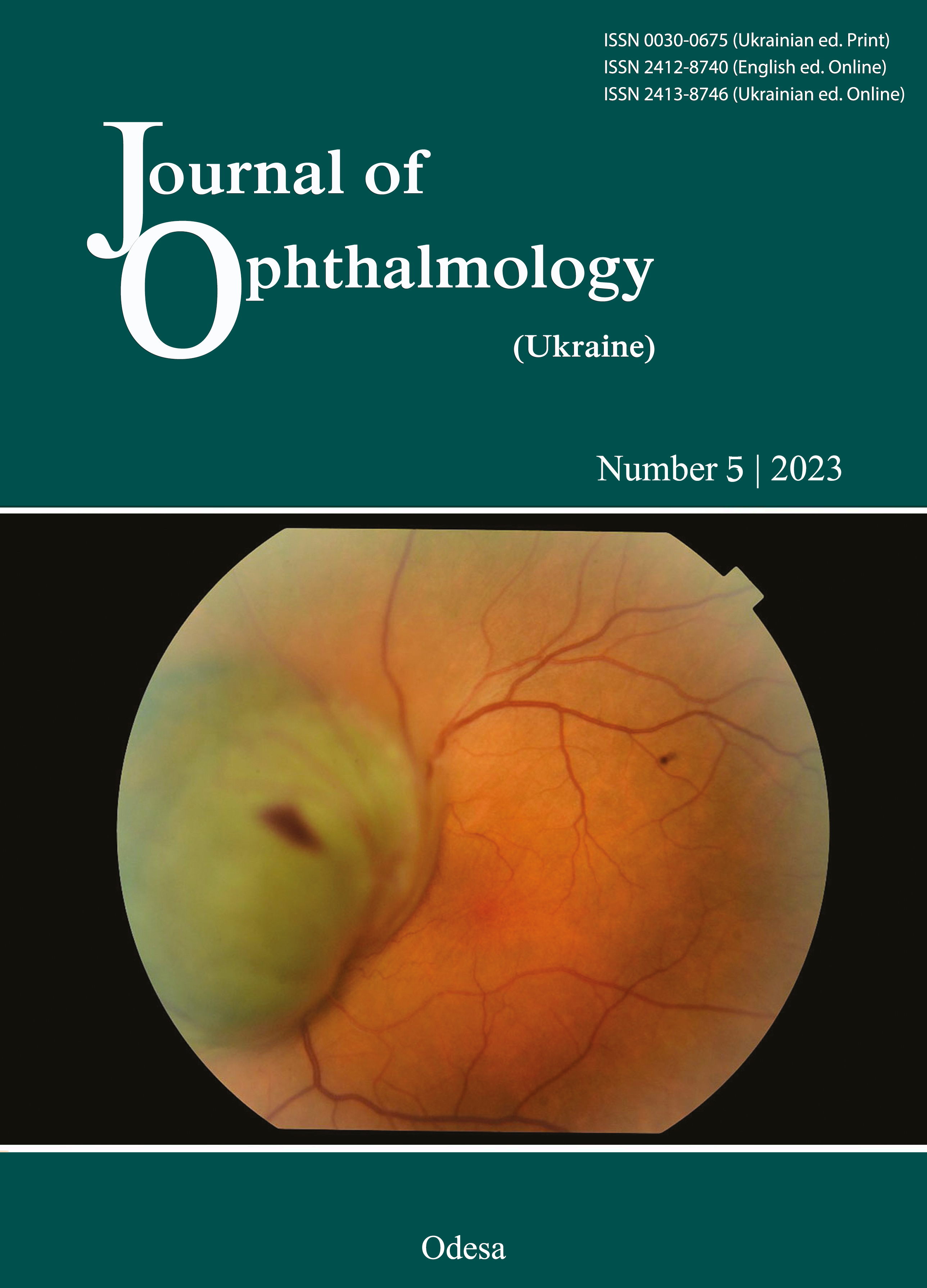Femtosecond laser LenSx–assisted phacoemulsification of mature intumescent cataract
DOI:
https://doi.org/10.31288/oftalmolzh202351115Keywords:
ultrasound phacoemulsification, senile brunescent cataract, senile Morgagnian cataract, femtosecond laserAbstract
Background: Phacoemulsification (phaco) of mature intumescent cataract is one of the most difficult to perform anterior eye surgeries. In mature intumescent cataract phaco, the most difficult phase is performing a continuous capsulorhexis which should be as round as possible. The incidence of an anterior capsular tear during capsulorhexis has been reported to range from 0.8 to 5.0% and increases with an increase in cataract density. This is because in dense intumescent cataracts, capsulorhexis tends to extend to the periphery due to high intracapsular pressure. Femtosecond laser–assisted phaco of mature intumescent cataract enables a safe laser-assisted capsulotomy with a substantially reduced risk of intraoperative complications. Because this approach is as yet not widely used in ophthalmology, we aimed to share our experience in the use of femtosecond laser in phacoemulsification of mature and intumescent cataracts.
Purpose: To assess the efficacy of femtosecond laser–assisted treatment of mature intumescent cataract.
Methods: Sixty-five patients (68 eyes) with mature intumescent senile cataract underwent femtosecond laser-assisted cataract surgery (FLACS) with intraocular lens (IOL) implantation and were involved in this study.
Results: In 55 eyes (80.8%), laser capsulotomy of the desired diameter (5.0 mm) was performed completely. In 8 eyes (11.7%), capsular bridges (capsular tissue remnants at the site of laser-assisted cut of the anterior capsule) were seen. In addition, after the laser phase of surgery, 3 eyes (4.4%) showed an irregularly shaped anterior capsular disc due to the failure of the laser to cut through the capsule in several regions. In all study eyes, the IOL was well centered in the bag.
Conclusion: In eyes with mature intumescent cataract, it is reasonable to use the femtosecond laser for a safe and accurate anterior capsulorhexis to avoid the severe intraoperative complications (those associated with posterior capsular rapture and vitreous prolapse) that can be seen during manual capsulorhexis.
References
Chee, Soon-Phaik, Chan N. Capsule milking: Modification of capsulorhexis technique for intumescent cataract. J Cataract Refract Surg. 2017;43(5):585-589. https://doi.org/10.1016/j.jcrs.2017.04.023
Genç S, Güler E, Çakır H, Özertürk Y. Intraoperative complications in intumescent cataract surgery using a phaco capsulotomy technique. J Cataract Refract Surg. 2016;42(8):1141-1145. https://doi.org/10.1016/j.jcrs.2016.06.025
Conrad-Hengerer I., Hengerer F., Joachim S., Schultz T., Dick B.. Femtosecond laser-assisted cataract surgery in intumescent white cataracts. J Cataract Refract Surg. 2014;40(1):44-50. https://doi.org/10.1016/j.jcrs.2013.08.044
Ifantides C, Sretavan D. Automated precision pulse capsulotomy vs manual capsulorhexis in white cataracts: reduction in procedural time and resource utilization. J Cataract Refract Surg. 2023;49(4):392-399. https://doi.org/10.1097/j.jcrs.0000000000001109
Perrone DM. Argentinian flag sign is most common complication for intumescent cataracts. Ocular Surgery News. Dec 2000:15.
Foster G, Allen Q, Ayres B, Devgan U, Hoffman R, Khandelwal S, et al. Phacoemulsification of the rock-hard dense nuclear cataract: Options and recommendations. J Cataract Refract Surg. 2018;44(7):905-16. https://doi.org/10.1016/j.jcrs.2018.03.038
Perrone DM, Perrone LD, Blanco A. Techniques to avoid Argentina flag sign. American Academy of Ophthalmology. Sеpt 15, 2020.
Dhingra D, Balyan M, Malhorta C, Rohilla V, Jakhar V, Jain AK. A multipronged approach to prevent Argentinian flag sign in intumescent cataracts. Indian J Ophthalmol. 2018;66:1304-1306. https://doi.org/10.4103/ijo.IJO_51_18
Dmytriiev SK, Grytsenko IA. [Phacoemulsification of age-related cataract with lenses of various density: A Monograph]. Odesa: Atroprint; 2022. Ukrainian.
[Unified clinical protocol of primary, secondary (specialized), tertiary (highly-specialized) medical care (Cataract) approved by the Order of Ministry of Health of Ukraine No 49 from January, 28, 2016]. Ukrainian.
Zhu Y, Chen X, Chen P, Xu W. Lens capsule-related complications of femtosecond laser-assisted capsulotomy versus manual capsulorhexis for white cataracts. J Cataract Refract Surg. 2019;45(3):337-342. https://doi.org/10.1016/j.jcrs.2018.10.037
Kara-Junior N, Kawakami A, Carricondo P. Mini-rhexis for white intumescent cataracts. Clinics. 2009;64:309-312. https://doi.org/10.1590/S1807-59322009000400007
Jacob S, Agarwal A, Agarwal S, Bagmar A. Trypan blue as an adjunct for safe phacoemulsification in eyes with white cataract. J Cataract Refract. Surg. 2002;28:1819-1825. https://doi.org/10.1016/S0886-3350(01)01316-5
Dick H, Aliyeva S, Hengerer F. Effect of trypan blue on the elasticity of the human anterior lens capsule. J Cataract Refract Surg. 2008;34:1367-1373. https://doi.org/10.1016/j.jcrs.2008.03.041
Hawlina M, Stunf S, Hvala A. Ultrastructure of anterior lens capsule of intumescent white cataract. Acta Ophthalmol. 2011;89:367-370. https://doi.org/10.1111/j.1755-3768.2010.02102.x
Chen X, Yu Y, Song X, Zhu Y, Wang W. Clinical outcomes of femtosecond laser-assisted cataract surgery versus conventional phacoemulsification surgery for hard nuclear cataracts. J Cataract Refract Surg. 2017;43:486-491. https://doi.org/10.1016/j.jcrs.2017.01.010
Chee S, Wong M, Jap A. Management of severely subluxated cataracts using femtosecond laser-assisted cataract surgery. Am J Ophthalmol. 2017;173:7-15. https://doi.org/10.1016/j.ajo.2016.09.021
Schultz T, Dick H. Laser-assisted mini-capsulotomy: a new technique for intumescent white cataracts. J Cataract Refract Surg. 2014;30:742-745. https://doi.org/10.3928/1081597X-20141021-05
Taravella M, Meghpara B, Frank G. Femtosecond laser-assisted cataract surgery in complex cases. J Cataract Refract Surg. 2016;42:813-816. https://doi.org/10.1016/j.jcrs.2016.02.049
Titiyal J, Kaur M, Singh A, Arora T. Comparative evaluation of femtosecond laser-assisted cataract surgery and conventional phacoemulsification in white cataract. Clin Ophthalmol. 2016;10:1357-1364. https://doi.org/10.2147/OPTH.S108243
Downloads
Published
How to Cite
Issue
Section
License
Copyright (c) 2023 Dmytriiev S. K., Grytsenko I. A.

This work is licensed under a Creative Commons Attribution 4.0 International License.
This work is licensed under a Creative Commons Attribution 4.0 International (CC BY 4.0) that allows users to read, download, copy, distribute, print, search, or link to the full texts of the articles, or use them for any other lawful purpose, without asking prior permission from the publisher or the author as long as they cite the source.
COPYRIGHT NOTICE
Authors who publish in this journal agree to the following terms:
- Authors hold copyright immediately after publication of their works and retain publishing rights without any restrictions.
- The copyright commencement date complies the publication date of the issue, where the article is included in.
DEPOSIT POLICY
- Authors are permitted and encouraged to post their work online (e.g., in institutional repositories or on their website) during the editorial process, as it can lead to productive exchanges, as well as earlier and greater citation of published work.
- Authors are able to enter into separate, additional contractual arrangements for the non-exclusive distribution of the journal's published version of the work with an acknowledgement of its initial publication in this journal.
- Post-print (post-refereeing manuscript version) and publisher's PDF-version self-archiving is allowed.
- Archiving the pre-print (pre-refereeing manuscript version) not allowed.












